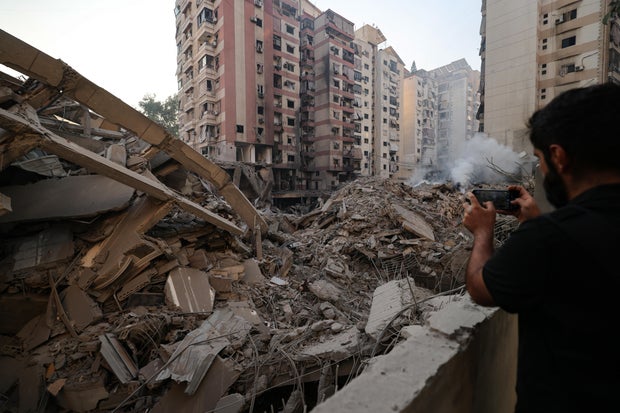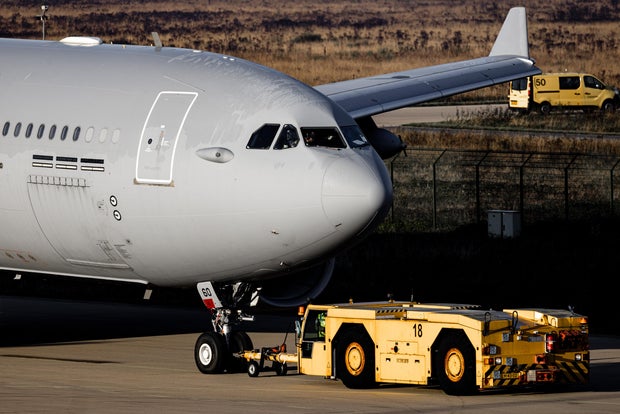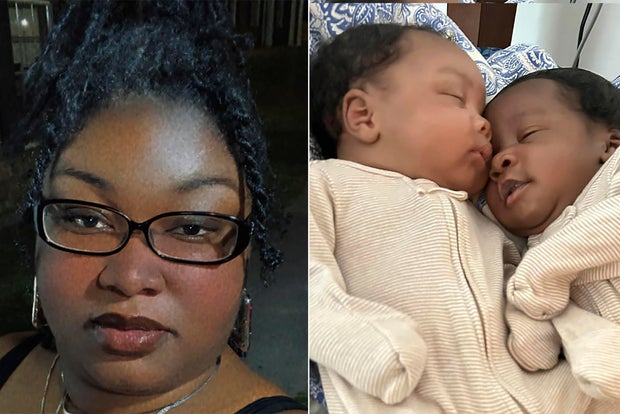CBS News
Iditarod musher Dallas Seavey penalized for not properly gutting moose that he killed to protect his dogs

Iditarod officials on Wednesday imposed a two-hour time penalty on musher Dallas Seavey for not properly gutting the moose he killed during the race earlier this week.
Race marshal Warren Palfrey convened a three-person panel of race officials to investigate the circumstances surrounding the death of the moose, which became tangled up with Seavey and his dog team early Monday, about 12 hours after the dayslong race officially started. One dog was injured in the encounter and flown back to Anchorage for care.
On Tuesday, Dallas Seavey Racing said on social media that the injured dog, named Faloo, was in critical condition. However, by Wednesday, the team provided an update, saying the dog was on the mend.
Ellamarie Quimby / AP
“This super dog received excellent care from the Iditarod vet team and the team of vets at PET ER and she was cleared to come home!” the team wrote on social media. “Undoubtedly this will be a relief for Dallas to hear since he tragically had to leave her early on in the race.”
If a musher kills a big game animal like a moose, caribou or buffalo in defense of life or property during the race, rules require they gut the animal and report it to officials at the next checkpoint.
Seavey, a five-time Iditarod champion, encountered the moose shortly after leaving the checkpoint in Skwentna. He used a handgun to shoot and kill it about 14 miles outside the village at 1:32 a.m. Monday.
According to the panel’s findings, Seavey spent about 10 minutes at the kill site, and then mushed his dog team about 11 miles before camping on a three-hour layover.
The team then departed at 5:55 a.m. for the next checkpoint, arriving in Finger Lake at 8 a.m., where Seavey reported the kill.
“It fell on my sled; it was sprawled on the trail,” Seavey told an Iditarod Insider television crew at the Finger Lake checkpoint, where he urged race officials to get the moose off the trail.
“I gutted it the best I could, but it was ugly,” he said.
A statement from the Iditarod said it had “been determined that the animal was not sufficiently gutted by the musher.” By definition, gutting includes taking out the intestines and other internal organs, officials said.
The Iditarod can impose time penalties if a majority of the three-person panel agrees a rule was broken and that a competitive advantage was gained. Penalties can range up to a maximum of eight hours per infraction.
Time penalties can be added to mandatory layovers each musher must take during the race or to a musher’s final time after they reach Nome.
Officials said the two-hour penalty will be added to Seavey’s mandatory 24-hour layover.
The moose was retrieved and its meat salvaged and processed. Iditarod associates in Skwentna were distributing the food.
Seavey was the first musher to reach the Cripple checkpoint, which is the halfway point of the race, officials said Wednesday night. By arriving first in Cripple, Seavey wins the Dorothy G. Page Halfway Award — named after the “Mother of the Iditarod” — and has a choice of either $3,000 in gold nuggets or a smartphone with a year of free mobile service.
Seavey was also the first musher to leave the checkpoint in the mining ghost town of Ophir, about 350 miles into the race after only staying for 15 minutes. Musher Jessie Holmes arrived in Ophir first, nearly two hours ahead of Seavey, but appeared to be resting. Four other mushers were also in Ophir.
The ceremonial start was held Saturday in Anchorage, with the competitive start beginning Sunday.
This year’s race has 38 mushers, who will travel about 1,000 miles across two mountain ranges, the frozen Yukon River and along the ice-covered Bering Sea. About 10 days after the start, they will come off the ice and onto Main Street in the old Gold Rush town of Nome for the last push to the finish line.
Seavey is not the first musher to have to kill a moose during an Iditarod. In February 2022, a moose attacked an Iditarod sled team, seriously injuring four dogs. Bridgett Watkins said on Facebook that the moose, after injuring her dogs, wouldn’t leave and that the ordeal stopped only after she called friends for help and one showed up with a high-powered rifle and killed the moose with one shot.
In 1985, the late Susan Butcher was leading the race when she used her axe and a parka to fend off a moose, but it killed two of her dogs and injured 13 others. Another musher came along and killed the moose.
CBS News
Israel airstrikes rock parts of Lebanon as Hezbollah launch rockets at air base near Haifa

The escalating fighting between Israel and Hezbollah continued Saturday as both sides traded strikes as the war in Gaza nears one year.
The Israel Defense Forces said its air force struck Hezbollah fighters inside a mosque in southern Lebanon that they said was used as a command center to “plan and execute terrorist attacks against IDF troops and the State of Israel.”
The mosque was adjacent to Salah Ghandour Hospital in the town of Bint Jbeil. The hospital said in a statement that Israeli forces had shelled it after being warned to evacuate. The shelling “resulted in nine members of the medical and nursing staff being injured, most of them seriously,” while most of the medical staff were evacuated. On Thursday, the World Health Organization said 28 health workers in Lebanon had been killed in the past 24 hours.
ANWAR AMRO/AFP via Getty Images
At the same time, 12 Israeli airstrikes hit Beirut’s southern suburbs, including one that badly damaged a large hall Hezbollah used to hold ceremonies, Lebanon’s state news agency said.
Later in the day, more strikes hit the area, from which tens of thousands of people have fled over the past two weeks.
Israeli airstrikes also hit areas in southern and eastern Lebanon, according to state media. At least six people were killed, according to NNA.
Meanwhile, Hezbollah said it launched a series of rockets at an Israeli air base near Haifa, about 30 miles from the Lebanese border. Israeli police said fragments of interceptors fell in several sites but no injuries were reported, according to the Associated Press.
Israel has sharply expanded its strikes on Lebanon in recent weeks after nearly a year of exchanging fire with the Iran-backed Hezbollah — long designated a terrorist organization by the U.S., Israel and many other nations. The IDF has been carrying out nightly bombardment of Beirut’s once densely populated southern suburbs, a stronghold of Hezbollah. Overnight, a military spokesman issued three alerts for residents there to evacuate.
Houssam Shbaro/Anadolu via Getty Images
Nearly a week of Israeli ground operations in southern Lebanon, near Israel’s northern border, and two weeks of airstrikes in that region and in southern Beirut — both Hezbollah strongholds — had killed more than 2,000 people, the health ministry said. More than 1 million people have been driven from their homes, including tens of thousands under Israel evacuation orders in almost 100 towns and villages near the border.
Hezbollah started launching those attacks in support of its ideological ally Hamas, which is also backed by Iran, the day after Hamas sparked the ongoing war in Gaza with its Oct. 7, 2023 terrorist attack on Israel. The IDF says Hezbollah militants have fired over 10,000 rockets across the border since Oct. 8, 2023. The vast majority of them have been intercepted by Israel’s advanced missile defense systems.
Israel conducts more ground raids
The Israeli military said on Saturday its special forces were carrying out ground raids against Hezbollah infrastructure in southern Lebanon, destroying missiles, launchpads, watchtowers and weapons storage facilities. The military said troops also dismantled tunnel shafts that Hezbollah used to approach the Israeli border.
Some 1.2 million people have been driven from their homes since Israel escalated its strikes in late September aiming to cripple Hezbollah and push it away from the countries’ shared border. On Tuesday, Israel launched what it calls a limited ground operation into southern Lebanon.
Nine Israeli troops have been killed in close fighting in the area in the past few days, which is saturated with arms and explosives, the military said.
Americans attempt to leave Lebanon
The U.S. government has warned Americans not to travel to Lebanon since mid-September and urged any citizens in the country to leave via commercial travel routes. As of Friday night, the U.S. State Department has assisted approximately 500 U.S. citizens, permanent residents and their families to leave Lebanon on flights organized by the agency.
Other nations are also working to evacuate their residents from Lebanon. Germany has evacuated 460 citizens on German military flights, while a Dutch military transport plane carried more than 100 citizens out of Lebanon. There were also citizens of Belgium, Finland and Ireland who were repatriated on that flight.
ROB ENGELAAR/ANP/AFP via Getty Images
“It’s great that these people are safely back in the Netherlands. These have been tense times for them,” Christiaan Rebergen, secretary-general of the foreign ministry, said after they landed Friday.
Fighting ongoing in Gaza
Palestinian medical officials say Israeli strikes in northern and central Gaza early Saturday have killed at least nine people, including two children.
One strike hit a group of people in the northern town of Beit Hanoun, killing at least five people, including two children, according to the Health Ministry’s Ambulance and Emergency service.
Another strike hit a house in the northern part of Nuseirat refugee camp, killing at least four people, the Awda hospital said. The strike also left a number of wounded people, it said.
The Israeli military did not have any immediate comment on the strikes but has long accused Hamas of operating from within civilian areas.
Earlier in the day, the Israeli military had warned residents in parts of central Gaza to evacuate, saying its forces would soon operate there in response to Palestinian militants.
The warnings cover areas along a strategic corridor in central Gaza, which was at the heart of obstacles to a ceasefire deal earlier this summer. The military warned Palestinians in areas of Nuseirat and Bureij refugee camps, located along the Netzarim corridor, to evacuate to an along Gaza’s shore called Muwasi, which the military has designated a humanitarian zone. It’s unclear how many Palestinians are currently living in the areas affected by the order, parts of which were evacuated previously.
Almost 42,000 Palestinians have been killed in Gaza during the almost year-long war, according to the Palestinian Health Ministry, which does not differentiate between civilian and militant deaths.
CBS News
1-month-old twins who died with mother believed to be the youngest-known Hurricane Helene victims

Month-old twin boys are believed to be the youngest known victims of Hurricane Helene. The boys died alongside their mother last week when a large tree fell through the roof of their home in Thomson, Georgia.
Obie Williams, grandfather of the twins, said he could hear babies crying and branches battering the windows when he spoke with his daughter, Kobe Williams, 27, on the phone last week as the storm tore through Georgia.
The single mother had been sitting in bed holding sons Khyzier and Khazmir and chatting on the phone with various family members while the storm raged outside.
AP
Kobe’s mother, Mary Jones, was staying with her daughter, helping her take care of the babies. She was on the other side of the trailer home when she heard a loud crash as a tree fell through the roof of her daughter’s bedroom.
“Kobe, Kobe, answer me, please,” Jones cried out in desperation, but she received no response.
Kobe and the twins were found dead.
“I’d seen pictures when they were born and pictures every day since, but I hadn’t made it out there yet to meet them,” Obie Williams told The Associated Press days after the storm ravaged eastern Georgia. “Now I’ll never get to meet my grandsons. It’s devastating.”
The babies, born Aug. 20, are the youngest known victims of a storm that had claimed more than 200 lives across Florida, Georgia, Tennessee, Virginia and the Carolinas. Among the other young victims are a 7-year-old girl and a 4-year-old boy from about 50 miles (80 kilometers) south in Washington County, Georgia.
“She was so excited to be a mother of those beautiful twin boys,” said Chiquita Jones-Hampton, Kobe’ Jones’ niece. “She was doing such a good job and was so proud to be their mom.”
Jones-Hampton, who considered Kobe a sister, said the family is in shock and heartbroken.
In Obie Williams’ home city of Augusta, 30 miles east of his daughter’s home in Thomson, power lines stretched along the sidewalks, tree branches blocked the roads and utility poles lay cracked and broken. The debris left him trapped in his neighborhood near the South Carolina border for a little over a day after the storm barreled through.
He said one of his sons dodged fallen trees and downed power lines to check on Kobe, and he could barely bear to tell his father what he found.
Many of his 14 other children are still without power in their homes across Georgia. Some have sought refuge in Atlanta, and others have traveled to Augusta to see their father and mourn together, he said.
He described his daughter as a lovable, social and strong woman. She always had a smile and loved to make people laugh, he said.
And she loved to dance, Jones-Hampton said.
“That was my baby,” Williams said. “And everybody loved her.”
CBS News
Telecom providers operate emergency communications after Hurricane Helene

Watch CBS News
Be the first to know
Get browser notifications for breaking news, live events, and exclusive reporting.













